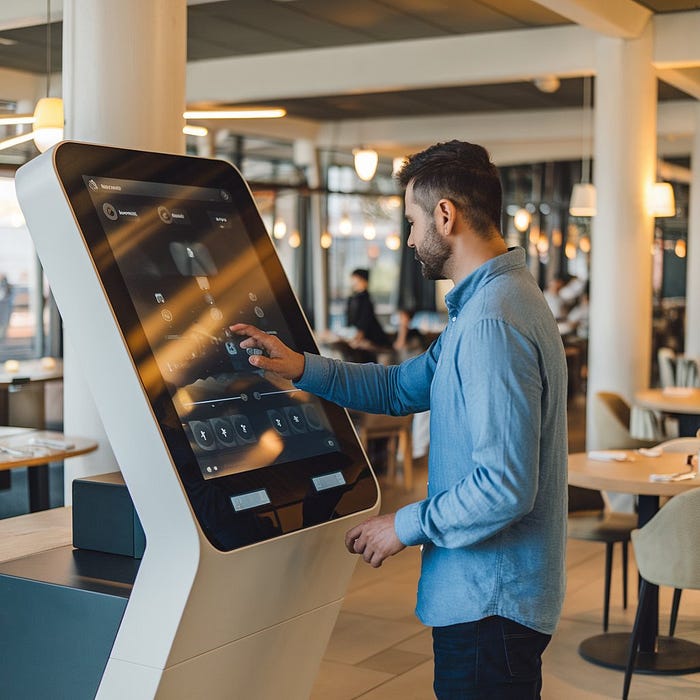Self service kiosk machine

In today’s fast-paced world, self-service kiosks have become a common sight across various industries. From ordering food at quick-service restaurants to checking in at airports, these kiosks offer a streamlined and efficient way for customers to interact with businesses. The rapid adoption of self-service technology is transforming how companies deliver services while enhancing customer convenience. This blog post will delve into the world of self-service kiosks, exploring their definition, benefits, challenges, and future trends.
What is a Self-Service Kiosk Machine?
A self-service kiosk machine is an interactive terminal that allows users to perform tasks independently without the assistance of a human staff member. These machines use advanced hardware and software to facilitate a variety of transactions, from purchasing products to gathering information. Unlike traditional service methods that require direct human interaction, self-service kiosks empower customers to complete tasks on their own, offering greater autonomy and efficiency.
Types of Self-Service Kiosks
Self-service kiosks come in various forms, each designed to cater to specific needs across different industries. Here are the primary types of self-service kiosks:
- Informational Kiosks: These kiosks provide users with information such as directories, maps, and event schedules. Commonly found in shopping malls, museums, and airports, they help users navigate complex spaces and access essential information.
- Transaction-Based Kiosks: These kiosks facilitate financial transactions, including bill payments, ticket purchases, and product orders. Examples include ATMs, self-checkout machines, and ticketing kiosks.
- Interactive Kiosks: These advanced kiosks offer a more engaging experience through touch screens and multimedia interfaces. They are used for customer feedback, virtual assistance, and product customization.
Components of a Self-Service Kiosk
Self-service kiosks are comprised of several essential components that work together to deliver seamless user experiences. These components include:
- Hardware:
- Touch Screens: Provide an intuitive interface for users to interact with the system.
- Printers: Used for generating receipts, tickets, or other physical documents.
- Payment Processing Systems: Enable secure transactions through credit cards, debit cards, and contactless payments.
- Barcode Scanners: Facilitate product identification and inventory management.
- Software:
- User Interface (UI): Ensures a user-friendly and responsive experience.
- Backend System: Manages data processing, transaction records, and system communication.
- Security Features: Safeguard sensitive information through encryption and authentication protocols.
Benefits of Self-Service Kiosk Machines
Self-service kiosks provide numerous advantages for both businesses and customers. These benefits span from operational efficiency to improved customer satisfaction.
Increased Efficiency
One of the most significant benefits of self-service kiosks is their ability to streamline operations and enhance service speed. By automating routine tasks, businesses can:
- Reduce Wait Times: Customers can complete transactions quickly without waiting for staff assistance.
- Boost Productivity: Employees can focus on more complex tasks, improving overall workflow.
- Handle High Volumes: Kiosks can process multiple transactions simultaneously, accommodating peak-hour demand.
Cost-Effectiveness
Implementing self-service kiosks can lead to substantial cost savings in the long run. Key cost-saving aspects include:
- Reduced Labor Costs: With kiosks handling routine transactions, businesses can optimize staffing levels.
- Minimized Errors: Automated systems decrease the likelihood of human error, reducing operational costs.
- Scalability: Kiosks can be easily scaled to accommodate business growth without proportional labor increases.
Enhanced Customer Experience
Self-service kiosks empower customers by offering greater control and convenience. Key aspects of improved customer experience include:
- 24/7 Availability: Kiosks can operate around the clock, allowing customers to access services anytime.
- Personalization: Advanced kiosks can tailor services based on customer preferences.
- Faster Service: Customers can complete tasks quickly and efficiently, enhancing satisfaction.

Challenges and Considerations
While self-service kiosks offer numerous benefits, their implementation also presents challenges that businesses must address.
Technical Issues
Technical challenges are common when deploying self-service kiosks. These issues can include:
- System Downtime: Hardware malfunctions or software glitches can disrupt service.
- Maintenance Requirements: Regular upkeep is necessary to ensure smooth operation.
- Security Concerns: Protecting sensitive customer data requires robust cybersecurity measures.
To mitigate these challenges, businesses should invest in reliable technology, conduct routine maintenance, and implement comprehensive security protocols.
User Acceptance and Training
Successful adoption of self-service kiosks depends on user acceptance and effective training. Challenges in this area include:
- User Resistance: Some customers may be hesitant to use unfamiliar technology.
- Accessibility Issues: Kiosks must be designed to accommodate diverse user needs, including those with disabilities.
- Staff Training: Employees should be trained to assist customers and troubleshoot technical issues.
Businesses can address these concerns by offering user-friendly interfaces, providing clear instructions, and conducting ongoing staff training.
Future Trends in Self-Service Kiosks
The self-service kiosk industry continues to evolve, driven by technological advancements and changing consumer preferences. Here are some emerging trends shaping the future of self-service kiosks:
Integration of AI and Machine Learning
Artificial intelligence (AI) and machine learning are enhancing the capabilities of self-service kiosks. These technologies enable:
- Intelligent Recommendations: AI can suggest products or services based on customer behavior.
- Natural Language Processing (NLP): Allows for voice-based interactions, improving accessibility.
- Predictive Maintenance: Machine learning can identify potential issues before they cause downtime.
Mobile and Contactless Solutions
The demand for mobile-enabled and contactless solutions is reshaping self-service kiosks. Key developments include:
- Mobile Integration: Customers can initiate and complete transactions via their smartphones.
- Contactless Payments: NFC technology allows secure and convenient payments without physical contact.
- QR Code Interaction: Enables seamless digital experiences through QR code scanning.
Conclusion
Self-service kiosks are transforming the way businesses interact with customers, offering increased efficiency, cost savings, and enhanced user experiences. While their implementation presents certain challenges, the benefits far outweigh the drawbacks when approached strategically. As technology continues to advance, innovations such as AI integration and mobile solutions will further elevate the capabilities of self-service kiosks.
Businesses that embrace this technology will be better equipped to meet the evolving needs of their customers, driving growth and staying competitive in the modern marketplace. Whether it’s reducing wait times, improving operational efficiency, or enhancing customer satisfaction, self-service kiosks are undoubtedly a powerful tool for the future.
Comments
Post a Comment